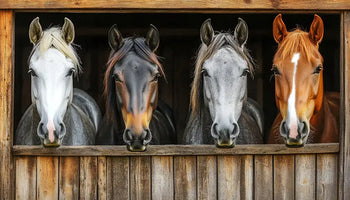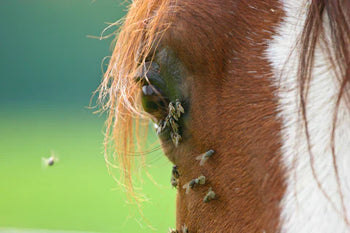

What Is A Fly Mask For Horses
Horse fly masks are a protective covering designed to shield a horse's face, particularly the eyes and sometimes ears, from flies and other insects. It's essentially a mesh hood that fits over the horse's head.
Basic Horse Fly Masks: The mask is made from fine mesh material that allows the horse to see clearly while preventing flies from reaching sensitive areas. It typically covers the area around both eyes and may extend to protect the forehead, cheeks, and sometimes the ears and nose.
How Do Fly Masks Work: The mesh is fine enough that flies cannot penetrate it, but open enough that it doesn't impair the horse's vision or breathing. Most masks attach with adjustable straps that go behind the ears and under the jaw, similar to how a halter fits.
Common Styles Of Fly Masks
- Standard eye protection - covers just the eye area
- Full face fly masks - extend down to cover the nose and muzzle
- Masks with ear protection - include mesh coverings for the ears
- Combo fly masks - some include neck pieces or throat coverage
Materials Fly Masks Are Made Of: Most are made from durable polyester or nylon mesh with reinforced seams. Higher-end versions may include UV-resistant materials, fleece padding around contact points, or special coatings.
When Horses Wear Fly Masks: Typically during fly season (spring through fall), especially during turnout in pastures. Some horses wear them 24/7 during peak fly season, while others only need them during the worst parts of the day.
The mask allows horses to graze, drink, and behave normally while providing continuous protection from the constant annoyance and potential health risks that flies present.
Table of contents
Why should I Use Fly Masks On My Horse
Fly masks serve several important protective purposes:
-
Eye protection is the primary benefit. Flies constantly irritating the eyes can cause excessive tearing, inflammation, and even corneal damage. Some flies actually feed on the proteins in tears, making eyes a prime target. For horses especially, this can lead to serious eye injuries or infections.
-
UV protection helps prevent sunburn around sensitive areas like the face, muzzle, and eye area. This is particularly important for animals with pink skin or light-colored faces who are prone to sun damage and even skin cancer.
-
Reduces stress and discomfort significantly. Constant head shaking, stamping, and agitation from flies affects an animal's ability to graze peacefully, rest properly, or focus during work. This stress can impact their overall health and performance.
-
Prevents fly-borne diseases by creating a physical barrier. Flies can transmit various conditions including conjunctivitis, summer sores, and other infections.
-
Helps with specific conditions like photosensitivity, where certain animals are extra sensitive to bright light, or when recovering from eye injuries where additional protection is needed.
-
Allows normal activities while providing protection. Quality masks don't restrict vision or eating, so animals can behave normally while staying protected.
The investment in a good fly mask typically pays off through reduced veterinary bills, less stress for both you and your animal, and improved quality of life during fly season. It's essentially preventive care that's much easier than treating problems after they develop.
Best Size and Fitting Fly Mask For My Horse
How do I know what size fly mask to buy?
Measure from the center of your horse's forehead, around the widest part of the face, back to the starting point. Most manufacturers provide sizing charts.
A properly fitted mask should be snug but not tight, with no gaps around the eyes but should not be touching the eyes.
Ensure your horses fly mask is too big or too small? An ill-fitting mask can cause rubbing, allow flies in, or fall off entirely. If too loose, it may slip and obstruct vision. If too tight, it can cause pressure sores. Most quality masks have adjustable straps for fine-tuning the fit.
-
Fly Masks Covering Your Horses Eyes : There should be enough room that the mask doesn't touch the eyelashes or eyeballs when the horse blinks. You should be able to slide a finger between the mask and the eye area.
-
Nose : The mask should clear the nostrils completely with room for normal breathing and eating.
-
Covering Your Horses Ears : Should fit through the openings without being pinched or pulled.
- Fly Mask Straps : Secure but not tight - you should be able to fit 1-2 fingers under any straps.
blinking and eye movement.
How To Look After Your Horses Fly Mask
How often should I clean my fly masks? It is best to clean masks regularly, ideally every few days or when visibly dirty. Daily brushing off of debris helps maintain airflow and visibility of Fly Masks.
Can I put fly masks in the washing machine? A: Most fly masks are machine washable on gentle cycles. Always check manufacturer instructions. Air drying is typically recommended to maintain the mesh integrity.
How long do fly masks last? Quality fly masks such as Equilibrium and Woof Wear can last multiple seasons with proper care. Factors affecting lifespan include frequency of use, horse's activity level, and maintenance. Replace fly masks when mesh becomes torn or straps lose elasticity.
Equilibrium Fly Masks
Styles Of Fly Masks For Horses
There are several different styles of fly masks, each designed for specific needs and situations:
One of the most basic fly masks is a fly fringe
These basic fly masks can be attached to a field safe headcollar or bridle whilst riding and have dangling straps that hang from the browband. Whilst these offer no UV Filter protection they will help to brush off flys from your horses face.
Nose fringe masks have dangling strips or fringe that hangs down around the nose area to deter flies while still allowing full access for eating and drinking. The movement of the fringe helps keep flies away from the muzzle.
Fly Masks For Horses Without Ears and Without Nose Cover
A number of brands such as Woof Wear, Equilibrium and LeMieux offer Fly Masks that offer basic coverage of your horses face.
These basic fly masks offer protection for your horses eyes. Cover just the eye area and are the most common type. They're lightweight, economical, and suitable for most horses during regular turnout. These basic fly masks typically have a simple crown strap and sometimes a throat latch.
Fly Masks For Horses With Ears
The next level of face protection for your horse is a fly mask that also covers your horses ears. This helps to prevent insects from irritating your horse around their ears.
These masks include sections that cover the ears partially or completely. These fly masks with ear protection help horses that are particularly bothered by flies around their ears or have sensitive ear tips prone to fly bites.
Full Face Fly Masks For Horses
For full face protection for your horse then you can buy a full face masks, these horse masks extend down to cover the entire muzzle and nose area, providing maximum protection from flies and UV rays.
These full fly masks for horses are ideal for horses with pink noses or those prone to sunburn, but they're bulkier and may interfere more with grazing.
Ride On Fly Masks For Horses
Ride On Fly Masks are a great way to have a happy horse whilst hacking, keeping the fly at bay whilst you are out riding.
These light weight fly masks are designed to offer maximum visibility for your horse whilst still offering protection against the flies whilst riding
Combo fly masks integrate fly mask features with other gear like halters or bridles. Some have breakaway features for safety during turnout.
Specialty masks include options for specific needs like extra padding for injured eyes, mesh windows for better visibility during riding, or reinforced versions for horses that are hard on their equipment.
Seasonal variations range from lightweight summer mesh to heavier winter versions that provide wind protection along with fly control.
Color options typically include neutral colors like black, brown, or gray, though some come in bright colors for better visibility in pastures.
The key is matching the mask style to your horse's specific needs, turnout situation, and sensitivity levels.
Summary Of When To Use Fly Masks
Fly masks offer protection from flies as well as UV protection
Ensure you have the right fit for your horse
Keep your horse's fly mask clean
Don't compromise on price for the comfort of your horse
Frequently Asked Questions About Fly Masks
Can my horse see clearly with a fly mask on?
Yes, quality fly masks use fine mesh that doesn't impair vision. Horses can see clearly enough to navigate, graze, and interact normally. The mesh is designed to be nearly invisible to them while blocking flies.
Can horses eat and drink with fly masks on?
Absolutely. Standard eye-protection masks don't cover the mouth or nose, allowing normal eating and drinking. Even full-face masks with nose coverage are designed with openings that permit these activities.
How long can a horse wear a fly mask?
Many horses wear fly masks 24/7 during fly season without issues. However, masks should be removed daily for inspection and cleaning, and to check for any rubbing or irritation.
Will the mask stay on in the pasture?
Well-fitted masks should stay in place during normal turnout activities. However, horses that are rough players or those turned out with aggressive pasture mates may pull masks off each other.
Should the mask touch my horse's eyes?
No, the mask should sit away from the eyes without touching the eyelashes or eyeball. There should be enough room for normal blinking and eye movement.










